 W
WTrue gobies were a subfamily, the Gobiinae, of the goby family Gobiidae, although the 5th edition of the Fishes of the World does not subdivide the Gobiidae into subfamilies. They are found in all oceans and a few rivers and lakes, but most live in warm waters. Altogether, the Gobiinae unite about 1149 described species in 160 genera, and new ones are still being discovered in numbers.
 W
WAmblyeleotris is a genus of fish in the family Gobiidae found throughout the Indo-Pacific region. This is the largest genus of the shrimp gobies or prawn gobies, so-called because of their symbiotic relationship with certain alpheid shrimps. The shrimp excavates and maintains a burrow used by both animals while the goby, which has far superior eyesight, acts as a lookout for predators. The shrimp maintains almost constant contact with the fish with an antenna. These species vary considerably in size from less than 30 mm to almost 200 mm standard length.
 W
WAmoya is a genus of gobies in the family Gobiidae native to the Indian Ocean and the western Pacific Ocean.
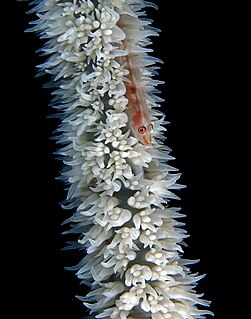 W
WBryaninops is a tropical Indo-Pacific genus of gobies. The genus takes its common name from the fact that it is commensal on gorgonians and black coral. The genus is further characterised by cryptic colouration.
 W
WChromogobius is a small genus of gobies native to the eastern Atlantic Ocean through the Mediterranean and Adriatic seas to the Black Sea.
 W
WCryptocentrus also known as Watchman gobies, and one of the genera known as shrimp gobies or prawn gobies, is a genus of gobies native to tropical marine waters of the Indian and Pacific oceans.
 W
WCtenogobiops is a genus of marine gobies native to the Indian and Pacific oceans.
 W
WDidogobius is a genus of small marine fish in the family Gobiidae, the true gobies. They are native to the eastern Atlantic Ocean and the Mediterranean Sea. The name of the genus is a compound noun made up of Dido, the mythical founder and first queen of Carthage, and the Latin gobius meaning "goby".
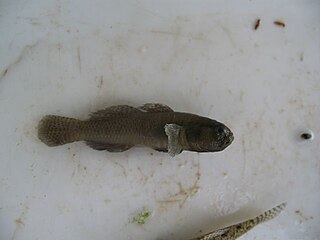 W
WEconomidichthys is a genus of freshwater gobies endemic to Greece. The name of this genus honours the Greek ichthyologist Panos Economidis.
 W
WElacatinus is a genus of small marine gobies, often known collectively as the neon gobies. Although only one species, E. oceanops, is technically the "neon goby," because of their similar appearance, other members of the genus are generally labeled neon gobies, as well. Except for a single East Pacific species, all reside in warmer parts of the West Atlantic, including the Caribbean and Gulf of Mexico. They are known for engaging in symbiosis with other marine creatures by providing them cleaning service that consists of getting rid of ectoparasites on their bodies. In return, Elacatinus species obtain their primary source of food, ectoparasites.
 W
WExyrias is a genus of gobies mostly native to marine waters of the Indian Ocean and the western Pacific Ocean with one freshwater species (E. volcanus) known from the Philippines.
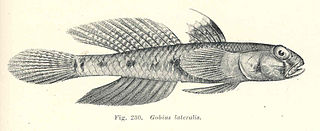 W
WFavonigobius is a genus of gobies native to fresh, brackish and marine waters around the Indian Ocean and the western Pacific Ocean. Commonly called "sand gobies", this term more alternatively refers to the family Kraemeriidae, a relative of the true gobies.
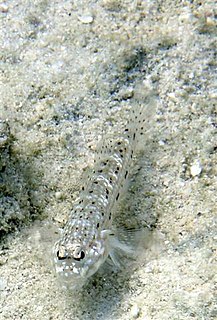 W
WFusigobius is a genus of coral reef inhabiting gobies found throughout the Indian and western Pacific Oceans.
 W
WGlossogobius is a genus of gobies native to fresh, brackish and marine waters from Africa to the coasts of the western Pacific Ocean. They are found in Madagascar, South Africa, Japan, Thailand, Australia, Indonesia, Bangladesh, the Philippines, Taiwan, Papua New Guinea, Singapore, Malawi, Swaziland, Botswana, Kenya, Zimbabwe, Tanzania, Mozambique, the Solomon Islands, Palau, Fiji, New Caledonia, India, Laos, Sri Lanka, Myanmar, Borneo, Nepal, Brunei Darussalam, Micronesia, Cambodia, Viet Nam, China, Réunion, the Seychelles, Mauritius, the Caroline Islands, Vanuatu, Malaysia and Russia. The genus also includes a troglobitic species, G. ankaranensis.
 W
WGobiodon is a genus of gobies also known as coral gobies or "clown gobies". Generally, coral gobies, unlike the rest of the family Gobiidae, are not burrowers, but instead prefer to inhabit the branches of certain Acropora or similar hard corals.
 W
WGobiopsis is a genus of fish in the family Gobiidae native to the Indian and Pacific Ocean.
 W
WGobius is a genus of fish in the family Gobiidae native to fresh, brackish and marine waters of and around Europe, Africa and Asia. It contains the typical gobies, being the type genus of the formerly recognised subfamily Gobiinae and family and the namesake genus of its order Gobiiformes.
 W
WThe grass goby is a species of goby native to the Mediterranean Sea, the Sea of Azov and the Black Sea. It is currently the only known member of its genus.
 W
WKnipowitschia is a genus of marine, fresh and brackish water gobies native to Eurasia. The genus name almost certainly honours Nikolai Mikhailovich Knipovich (1862-1938), a biologist who led a number of expeditions to the Caspian Sea.
 W
WKoumansetta is a small genus of gobies native to the Indian Ocean and the western Pacific Ocean. The name of this genus honours the Dutch ichthyologist and goby taxonomist Frederik Petrus Koumans (1905-1977) of the Rijksmuseum van Natuurlijke Historie in Leiden, Netherlands, who had written a description of Koumansetta rainfordi following a visit to the Australian Museum in Sydney in 1938 but did not name it. The outbreak of World War 2 meant that Whitley's correspondence with Koumans was interrupted, so he named this genus after him, noting “which will enshrine memories of happier days of our meetings in Leiden and Sydney”.
 W
WMillerigobius macrocephalus is a species of goby native to coastal waters of the Adriatic Sea, the Levant Sea, the western Mediterranean and the Aegean Sea where it occurs in lagoons and shallow inshore waters to about 4 metres (13 ft) in depth with stones to provide shelter. This species can reach a length of 4.3 centimetres (1.7 in) SL. It is currently the only known member of its genus.
 W
WLesueurigobius is a genus of gobies native to the eastern Atlantic Ocean. The generic name honours the French naturalist Charles Alexandre Lesueur (1778-1846), for whom the type species, Lesueurigobius suerii, was named, Georg Duncker's name Lesueuria being preoccupied by a genus of comb jellies.
 W
WLythrypnus dalli, the Blue-banded goby or Catalina Goby is a species of goby native to the eastern Pacific from Monterey Bay (California) to northern Peru, including the Gulf of California. It can be found in coastal waters at depths of from 0 to 76 metres with rocky substrates in which there are crevices for concealment. It is also known to hide amongst the spines of sea urchins. It is a bidirectional hermaphrodite and capable of rapidly switching sexes. This species can reach a length of 6.4 centimetres (2.5 in) TL. It can also be found in the aquarium trade. The specific name honours the malacologist William Healey Dall (1845-1927), who when trawling for specimens off Catalina Harbour, California, caught one of the type specimens.
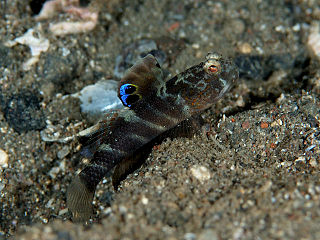 W
WMahidolia mystacina, the flagfin prawn goby, flagfin shrimpgoby or smiling goby, is a species of goby native to the Indian Ocean and the Pacific Ocean from Delagoa Bay, Mozambique to the Society Islands and from southern Japan to Samoa and northern Australia. This species occurs in marine and brackish waters, being found in coastal bays, estuaries and reef bases where the bottom is silty or muddy at depths of from 5 to 25 metres. This species is a commensal with a species of alpheid shrimp, using its burrow as its home. This species can reach a length of 8 centimetres (3.1 in) TL. This species can also be found in the aquarium trade. It is currently the only known member of its genus.
 W
WOplopomus is a genus of gobies found in coral reefs of the Indo-Pacific region. It contains two species.
 W
WOplopomus oplopomus, commonly known as the spinecheek goby, is a species of goby native to the Indo-Pacific region. They can grow to a maximum length of 10 centimetres (3.9 in). They inhabit coral reefs.
 W
WPadogobius is a genus of fish in the family Gobiidae, the gobies. They are native to fresh waters of southern Europe.
 W
WPomatoschistus is a genus of gobies native to fresh, brackish and marine waters of Europe, the eastern Atlantic Ocean and the Mediterranean Sea.
 W
WPriolepis is a genus of fish in the family Gobiidae with a cosmopolitan distribution.
 W
WRhinogobiops nicholsii, the blackeye goby, is a species of true goby in the family Gobiidae. It is the sole species classified under the genus Rhinogobiops. They are common inhabitants of coral reefs and rocky habitats along the Eastern Pacific Ocean coasts of Mexico, the United States, and Canada, although they are hardly noticed, as they often rest motionless near their shelters. Other common names for the species include bluespot goby and crested goby.
 W
Wthe Two Spot Goby, or Crab-eyed Goby, is a species of goby native to the Western Pacific Ocean where they can be found in areas of sand, silt in lagoons, or coastal bays with nearby cover such as rubble, coral, or leaf litter. They can be found at depths of from 1 to 30 metres. This species can reach a length of 10 centimetres (3.9 in) SL. It can also be found in the aquarium trade. It is currently the only known member of its genus.
 W
WTomiyamichthys is a genus of gobies found from the Red Sea through the Indian Ocean to the western Pacific Ocean. The name of this genus honours the Japanese ichthyologist Itiro Tomiyama of the Tokyo Imperial University, who described the type species, Tomiyamichthys oni, in 1936.
 W
WAphia minuta, the transparent goby, is a species of the goby native to the northeastern Atlantic Ocean where it can be found from Trondheim, Norway to Morocco. It is also found in the Mediterranean, Black Sea and the Sea of Azov. It is a pelagic species, inhabiting inshore waters and estuaries. It can be found at depths of from the surface to 97 metres (318 ft), though it is usually found at 5 to 80 metres, over sandy and muddy bottoms and also in eelgrass beds. This species can reach a length of 7.9 centimetres (3.1 in) TL. It is an important species to local commercial fisheries. It is currently the only known member of its genus.
 W
WThe two-spotted goby is a species of goby native to marine and brackish waters of the eastern Atlantic Ocean where it can be found from the Faeroes and Norway to the northwestern coast of Spain. It has also been recorded from Estonia though records from the Mediterranean Sea are uncertain. They are common on all coasts of the United Kingdom. This species can reach a length of 6 centimetres (2.4 in) TL.
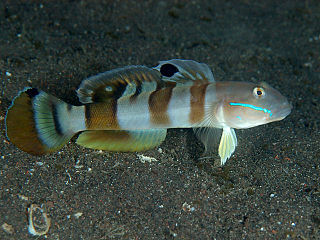 W
WValenciennea is a genus of small, bottom-dwelling fish in the family Gobiidae. They are found over sandy bottoms, often at coral reefs in the Indo-Pacific. The members of the genus tend to rest directly on the substrate for extended periods of time. While this is a common behavior for members of the family, this genus also float motionless directly above the substrate, which is why they are sometimes called glider gobies. Their resting behavior has resulted in the vernacular name "sleeper gobies", which invites confusion with the related family Eleotridae. The members of this genus are known to be carnivorous sand-sifters; to eat, they simply engulf entire mouthfuls of sand which they expel through their gills. Specialized structures in their gills filter small crustaceans and worms as the sand is expelled. It is this specific trait that makes some members of the genus attractive to the marine aquarist, and they are often introduced into a marine aquarium for sand-sifting. Some of the species are known to be monogamous. The genus was named after notable French zoologist Achille Valenciennes. These fish are difficult to keep in a tank. Tanks with plenty of live sand and live rock are recommended. Offer foods such as sinking shrimp pellets. Fish may die even if eating properly.
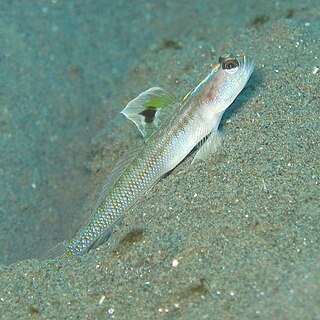 W
WVanderhorstia is a genus of gobies native to the Indian and Pacific oceans. The name of this genus honours the Dutch biologist Cornelius van der Horst (1889-1951) of the University of The Witwatersrand, Johannesburg, who was well known for his interest in marine biology.
 W
WThe zebra goby is a species of goby native to the Mediterranean Sea, where it occurs in lagoons and tide pools at depths down to 3 m (9.8 ft). It prefers areas of concealment, such as within patches of seagrass or algae or underneath stones. This species grows to a total length of 5.5 cm (2.2 in). This species is the only known member of its genus.